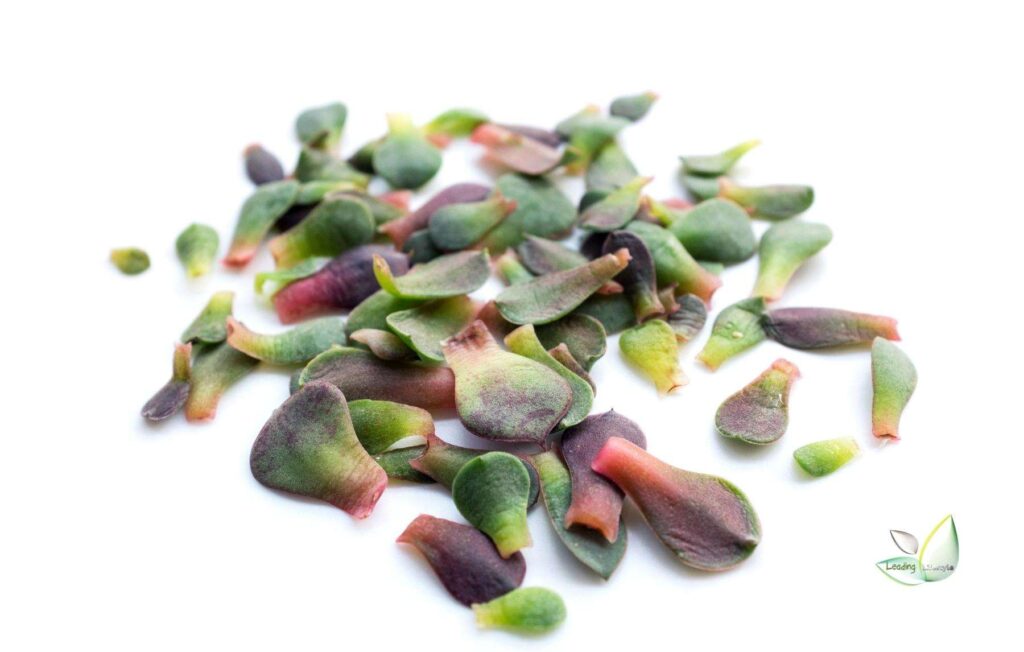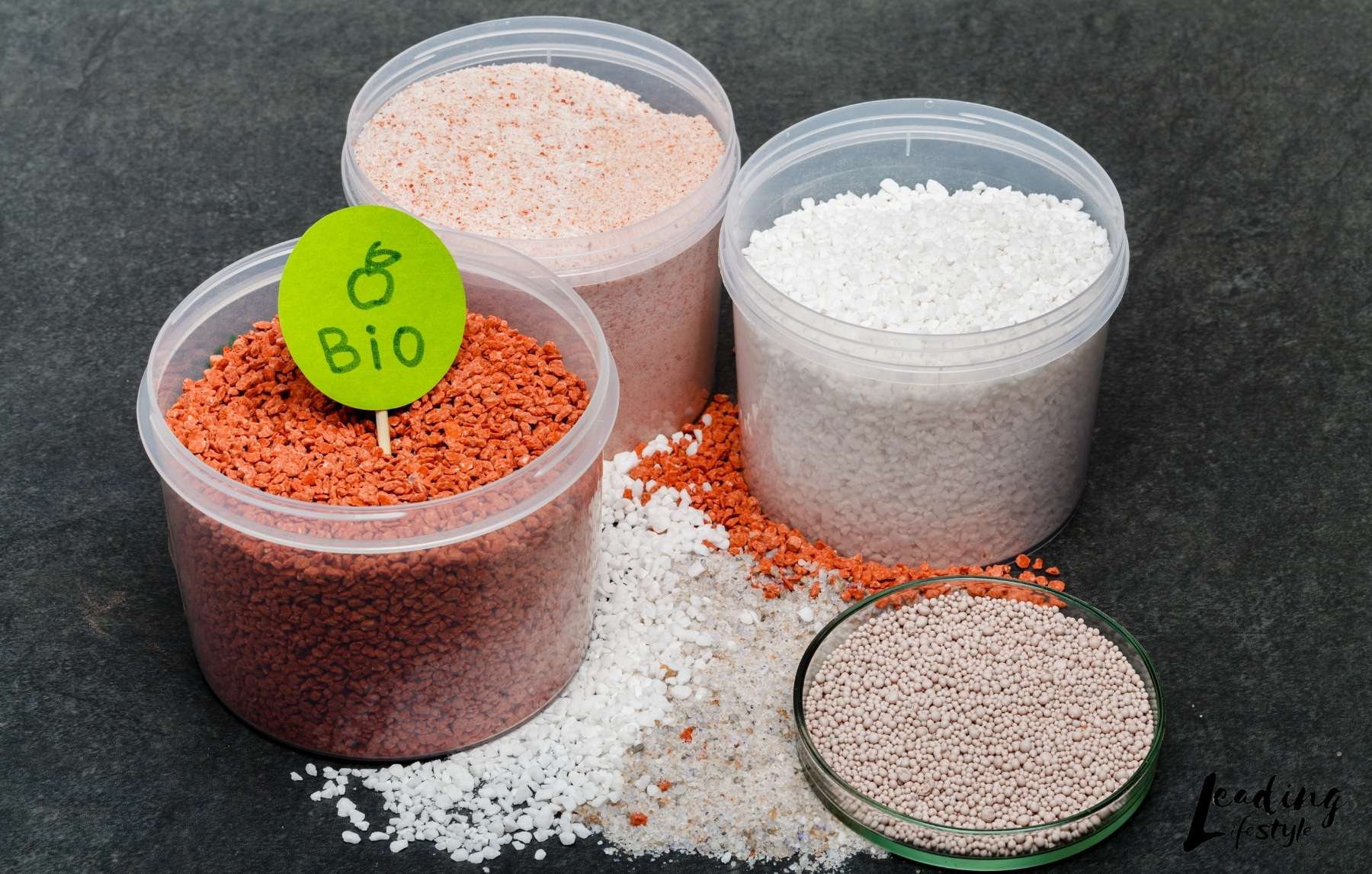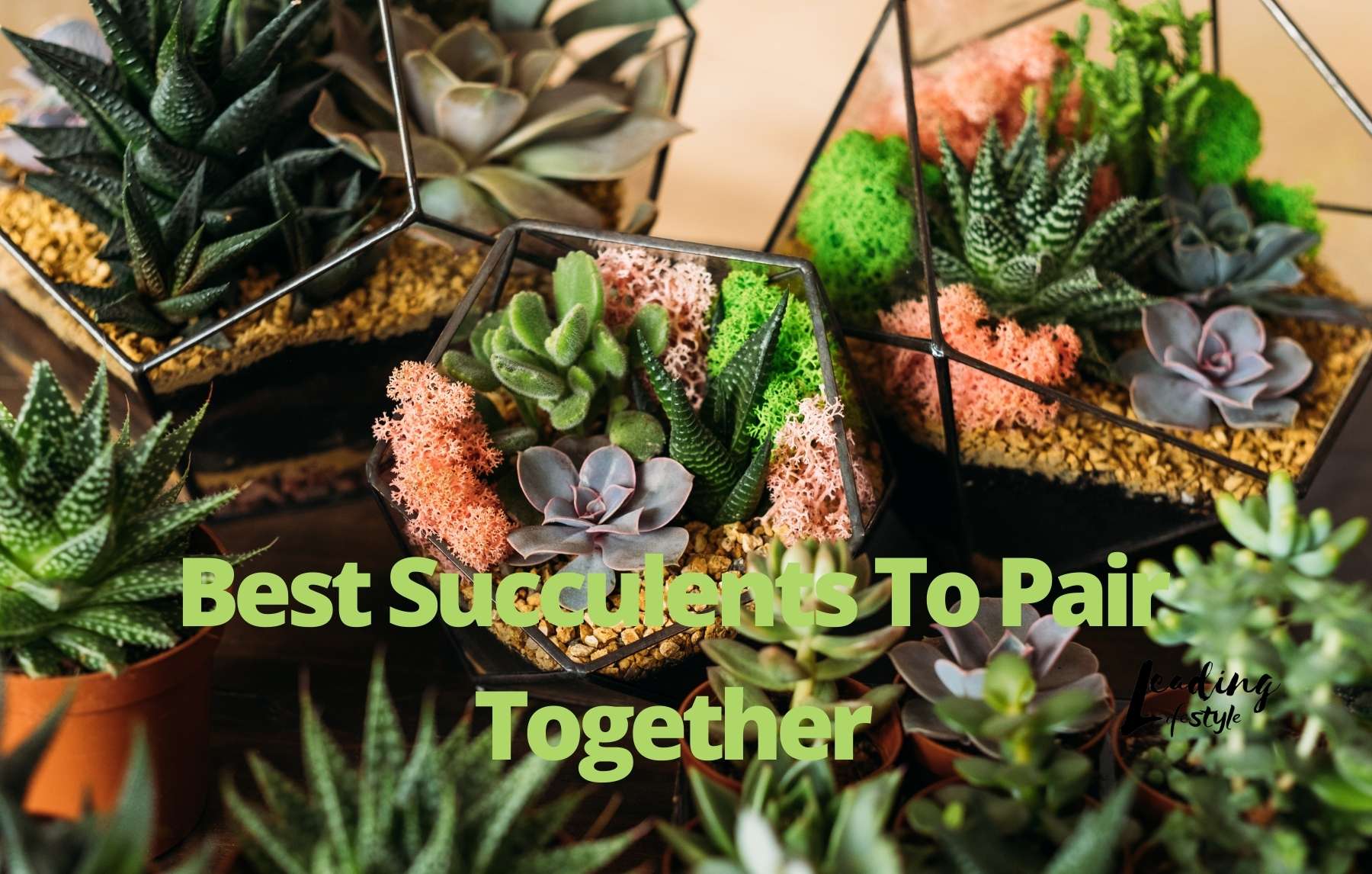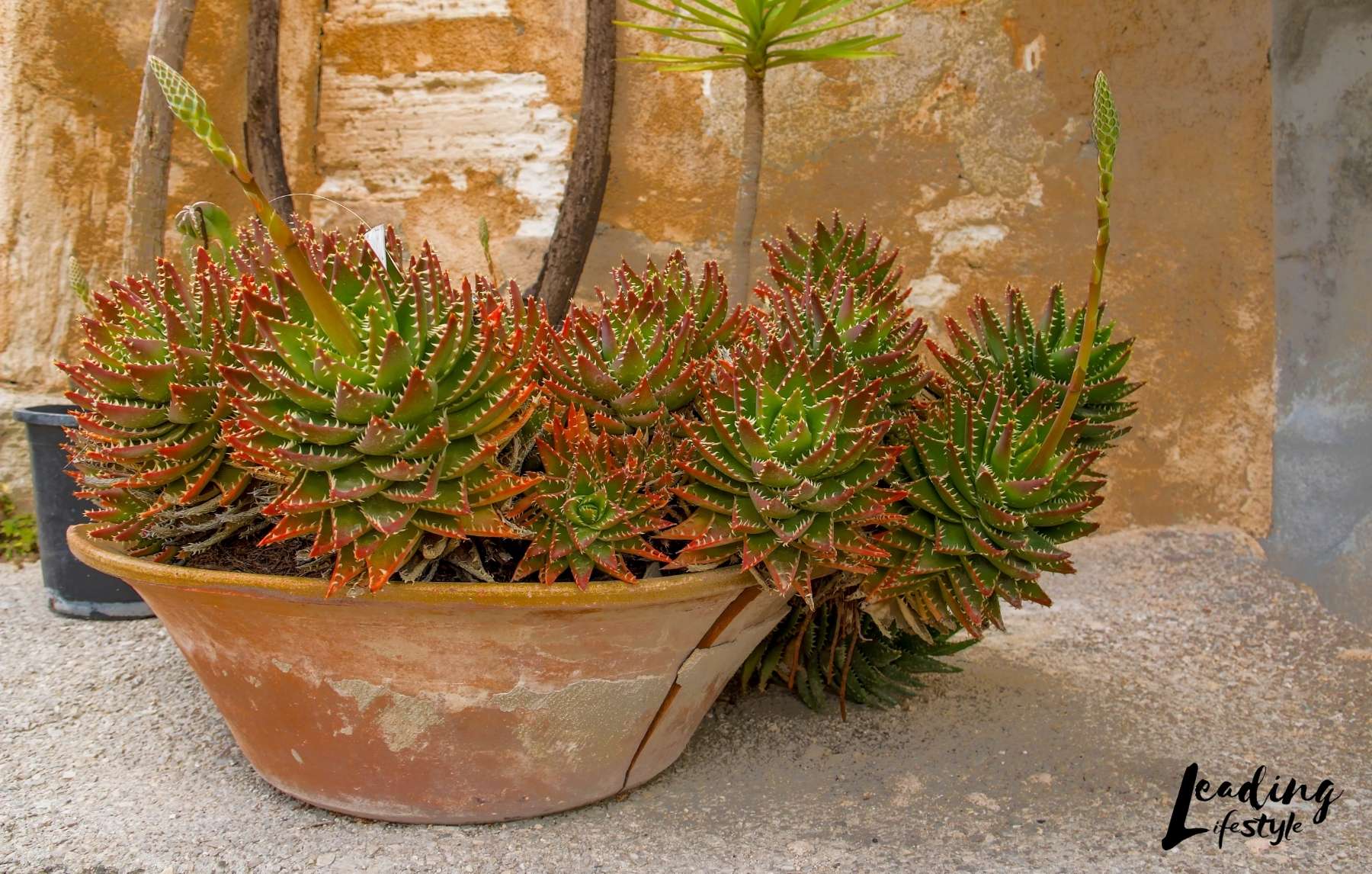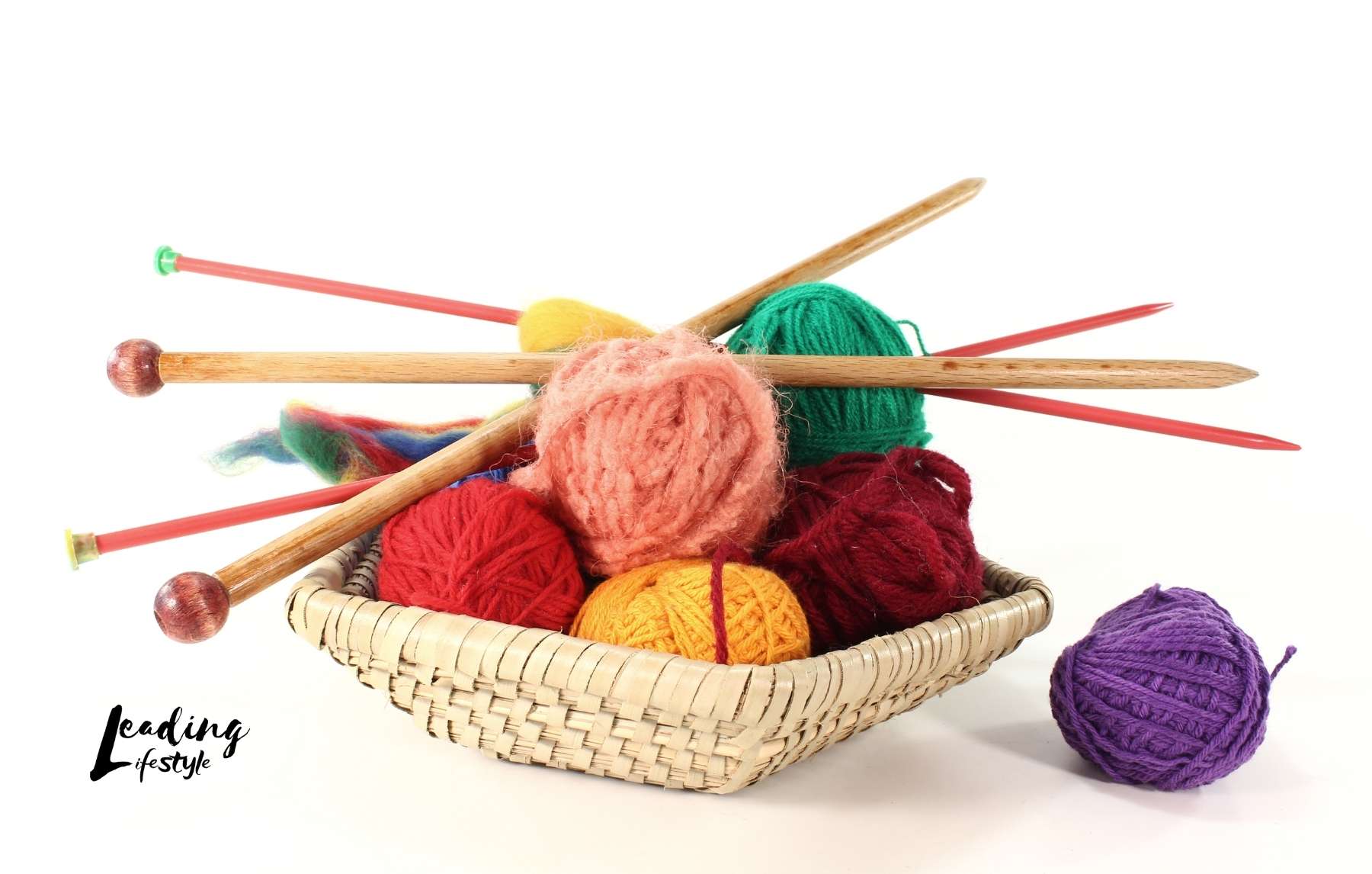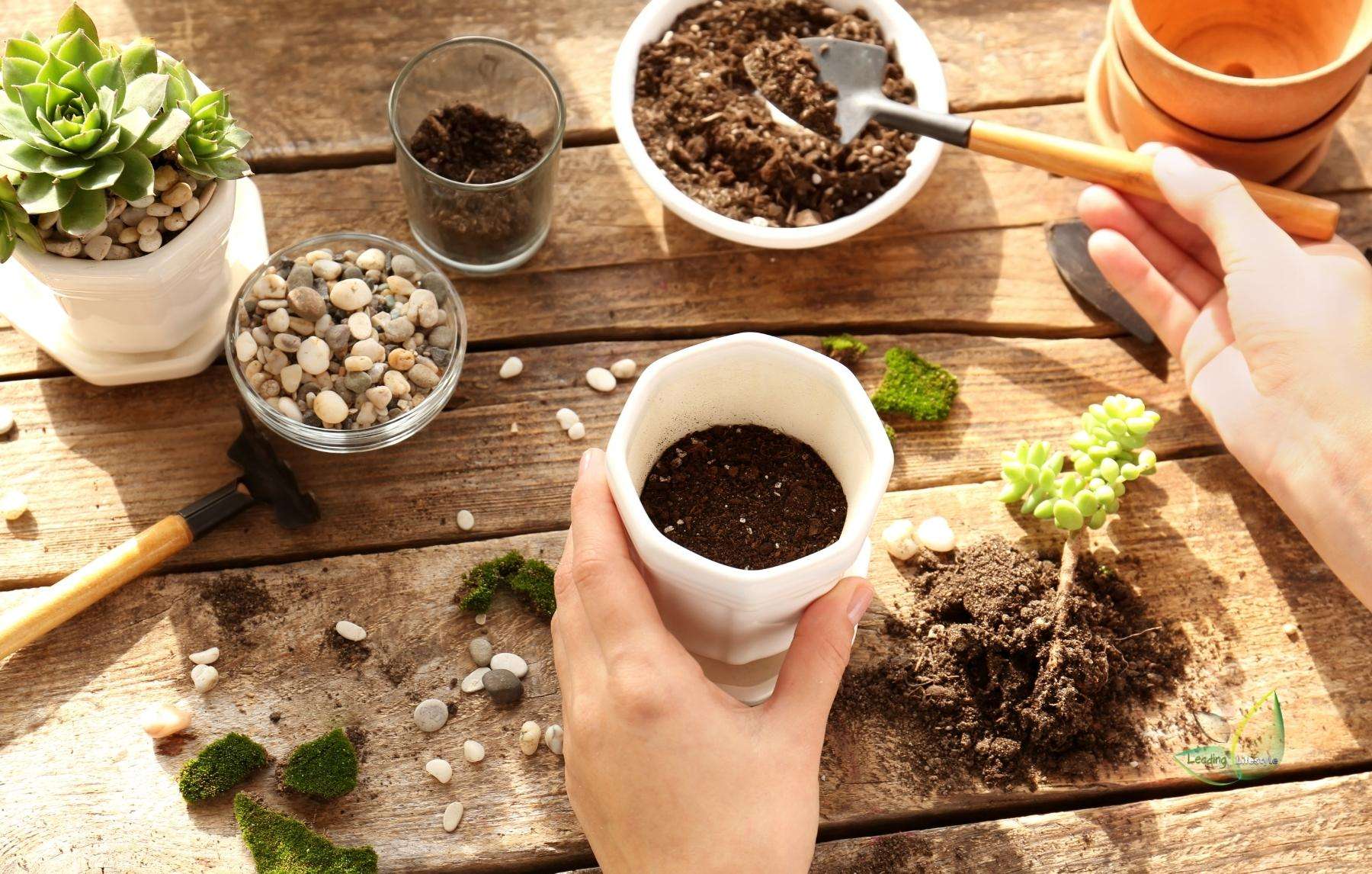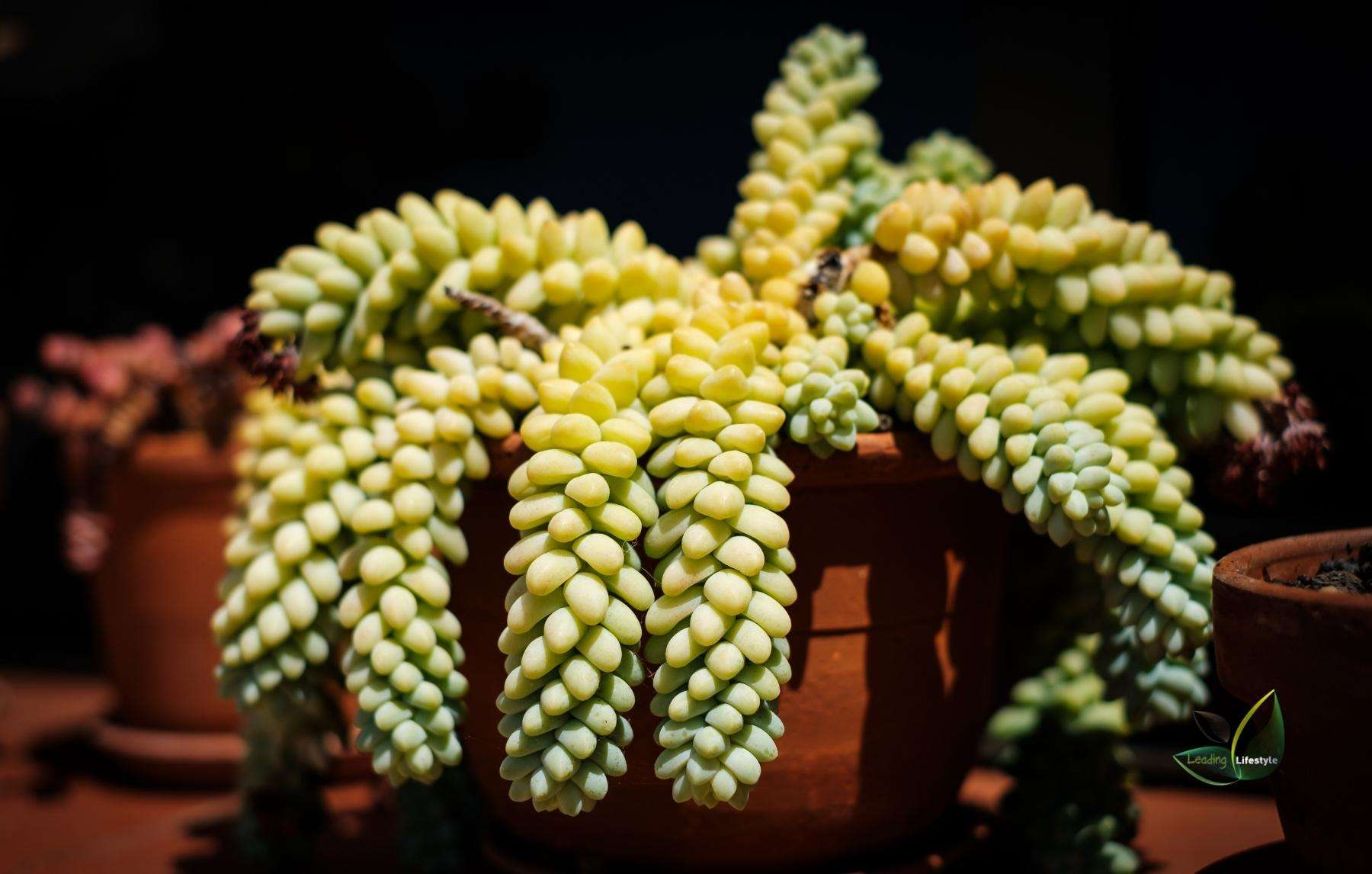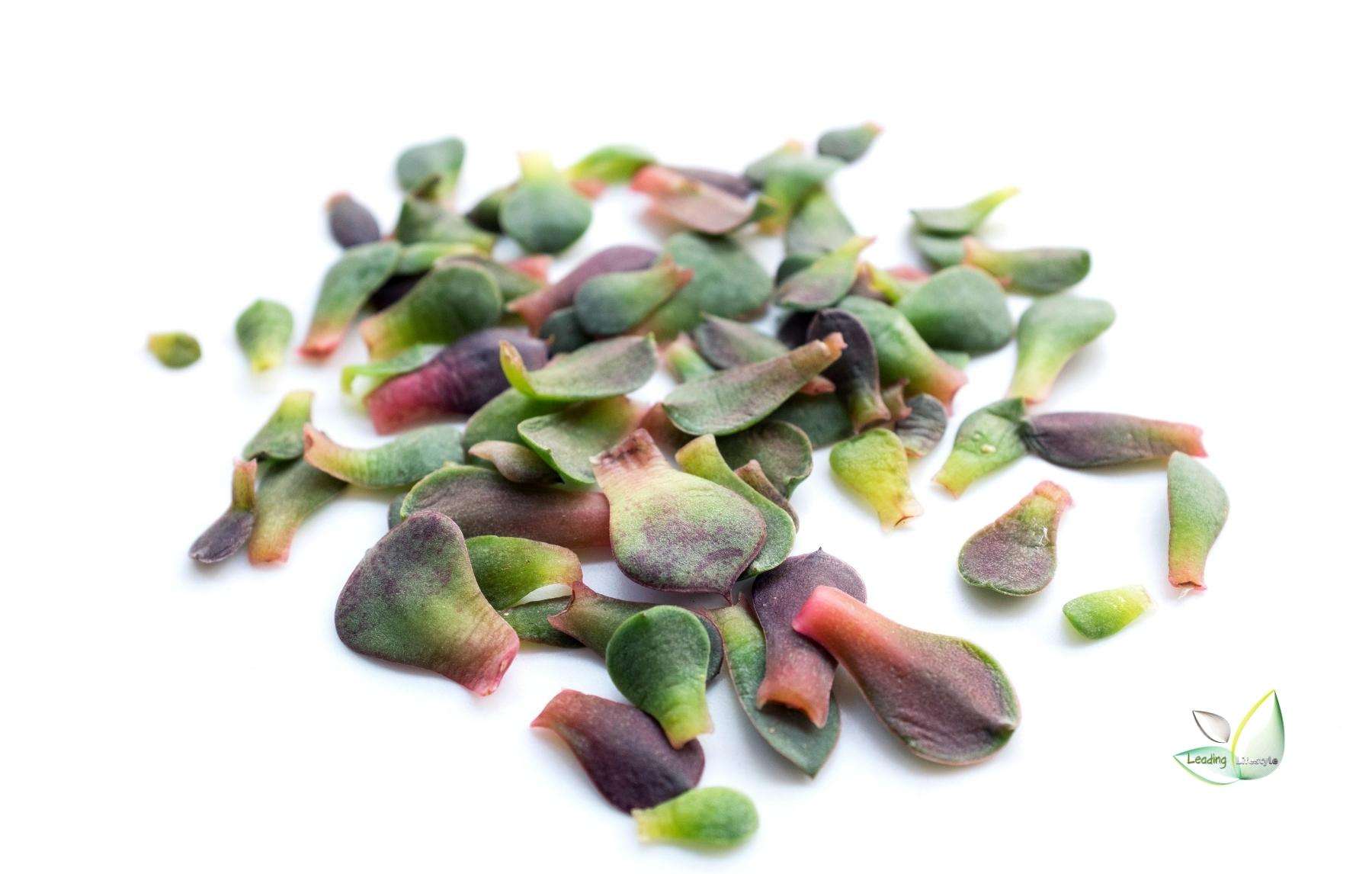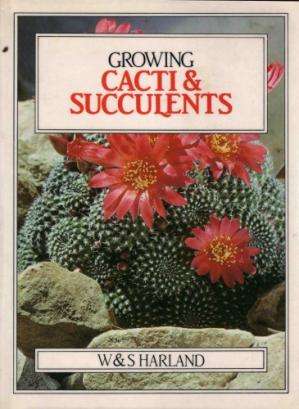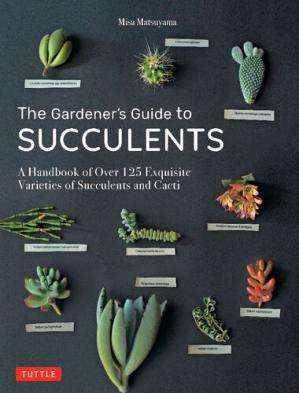Succulent leaves falling off can be caused by a variety of reasons. It can be due to poor drainage, overwatering, too much sun, too much water, a lack of nutrients, pests, or even lack of light.
If you are growing a succulent indoors, the best way to prevent this is to place the pot in a potting mix high in organic matter and drain excess water well. A minimum of six hours of direct sunlight per day is required if your succulent is kept outside.
Succulents, which are plants with thick, fleshy leaves, respond to changes in the environment by stopping growing and shedding their leaves to save energy.
Extreme temperatures, light intensity, improper watering, and chemical stress can cause leaves to fall off succulents. Succulents are easy to care for but not indestructible. So, if you’re new to the succulent world, a sick plant can be frustrating.
It’s easy to tell when your succulent is sick. When it starts falling leaves left and right, you know, it’s not strong or happy. But it’s hard to tell why your succulent babies are having so much trouble!
Many factors affect plant health. Water, sunlight, temperature, soil, and even the pot your plant is in can all harm its health.
How can you care with so many variables?
This article contains an excellent guide on caring for succulents during the winter, dormant months.
We’re here for you today! We can’t come to your house and diagnose your plant, but we can provide you with the information you need to figure it out. By the end of this post, you’ll be a plant doctor!
Why are my succulent leaves falling off?
When your succulent is in distress, it’s not that difficult to see. It’s not happy when it starts dumping leaves all over the place. However, it’s not as easy to figure out why your succulents are giving trouble.
If you notice leaves falling off succulents and are unsure of what to do, in most cases, you can easily nurse your plant back to health; you need to identify the cause of the problem to solve it.
Succulent Leaves Falling off occurs naturally as a result of the growth process or as a response to environmental stress, which can include the following:
- a requirement for energy consumption reductions.
- Excessive or insufficient water.
- excessive darkness
- chemical shock
- Extreme heat, extreme cold
- … and a few more.
Checklist for Succulent Healthcare
Here’s a checklist to help you figure out why your succulent leaves are falling off:
- Determine whether the leaf loss is normal or if it is excessive.
- Transparent, yellow, and squishy leaves
- Are the succulents’ leaves falling off at the top or bottom?
- Is the soil frequently wet?
- Is the soil prepared specifically for succulents?
- How well-compacted and water-retentive is the soil?
- Is the succulent container equipped with drainage holes?
Causes of Succulent Leaves Falling Off
A Reduction in Energy Consumption Is Required
Sign: The lower leaves of the succulents are turning brown and crispy.
When leaves fall off succulents, people frequently panic, especially if they are unfamiliar with succulents. However, did you know that most houseplants drop their bottom leaves naturally as they grow?
Those leaves have outlived their usefulness, as the plant’s higher leaves have absorbed them near the top. There is no reason to be concerned if it only loses the bottom leaves occasionally.
Do the following:
This is a natural process by which the plant extracts as much energy as possible from its leaves before shedding them. Therefore, you can either ignore them until they fall naturally or, if you find them unsightly, carefully remove the browned leaves.
Too Much Water
Sign: Succulent leaves become pliable, translucent, and yellowish in color.
Because a submerged succulent leaf can appear soft and squishy, this is a bit confusing. However, the yellow coloration of the leaves and signs of root rot when you lift the plant from its pot are dead giveaways.
Succulents are known for their low water requirements, and while too little water will cause them to wilt, you must be careful not to overwater them. Watering succulents excessively and frequently can cause their leaves to swell and eventually fall off the plant.
Water succulents properly by waiting until the soil is nearly dry and wrinkled leaves appear. Then, thoroughly water until excess water begins to drain from the drainage holes in the pot. As a result, when growing succulents, always use pots with drainage holes.
When your plant gets too much water, there can be some very bad consequences for it! It can cause root rot, cause your succulent leaves to fall off, and even cause the plant to die completely.
If you overwater your succulents, they’ll die. This is one of the easiest ways to kill them. It’s time to use the watering can to cool down your succulents if their leaves are getting mushy, soggy, and falling off regularly!
Do the following:
Eliminate all affected leaves from the succulent that has been over-watered. Check to see if the stem has rotted. If it has, cut off the rotted part and keep the healthy part in a dry place for a week. During this time, stop watering the plant.
After a week, repot the healthy portion of the plant and adhere to a proper watering schedule from now on. Because drainage is critical for succulents, it’s a good idea to plant them in a gritty soil mix (such as the ones found here) and a container with drainage holes at the bottom.
As long as the soil in which your succulents are planted is arid to the touch, it would be best if you only watered them when they need it the most. You’re likely to water your succulents once or twice a week.
Your succulent leaves should fully recover in no time if you alter your watering schedule.
Too little water
Sign: The leaves of succulent plants are wrinkled and shrunk.
While succulent leaves falling off frequently is frequently associated with overwatering, it can also occur due to underwatering. If you neglect to water your outdoor succulents for an extended period, they may appear weak and begin to wilt.
It’s easy to tell if a succulent has been submerged because its leaves are soft and wrinkled. In comparison to overwatered leaves, little color change is visible. As soon as they’re touched, some leaves will fall off, and even if the succulent is watered, it won’t grow back no matter how much. back no matter how much.
Do the following:
As long as your succulent hasn’t been completely submerged, you can generally bring it back to life. Increase your watering frequency slightly (not excessively), and your succulents will become much happier.
Too little light
Sign: Overall, the succulent is straggly. New leaves are getting smaller in size.
Succulents can begin to drop their leaves if kept in low light conditions for an extended period. If your plant appears tall and stretched out, you’ll know it has this problem.
Sun-deprived succulents will also begin to grow toward a source of light. Therefore, if your plant appears to be growing sideways to reach a window, this is another indication that there is a lack of light.
Fortunately, this is a relatively simple issue to resolve! All you need to do is move your plant somewhere brighter or put it under a grow light like this one.
For more grow lights we like, check out our article here!
However, before taking it outside and exposing it to the sun’s scorching rays, be sure to acclimate it first! Plants, too, develop sun spots and burn!
Do the following:
Your Plant Must Be Acclimatized to the Outdoor Environment. It would be best if you only let your plant get a little sunlight or artificial light for the first few days. Any more than that, and you risk sunburning it.
Increase the length of sun exposure gradually over a few weeks until your succulent receives approximately six hours of bright sunlight per day or approximately 12 hours of artificial light.
A little extra sun on your succulents should put an end to their leaf-dropping behavior.
However, you cannot undo some of the damage, such as your succulent’s stretched-out appearance. You can grow new plants from your original plant. They won’t look like they’ve been stretched out.
However, increasing the amount of sunlight on your original plant won’t make it as compact as when you bought it. That’s unfortunate.
Chemical Shock
Sign: Leaves and stems that are limp, wilted, crinkled, brittle, or very small.
Shocking a succulent’s system can also result in losing its leaves. When succulents get fungal infections or diseases, it’s tempting to act quickly and excessively, but you should be careful.
Follow the directions on the package, and don’t use more than the recommended amount when you use any chemical.
Additionally, always check to ensure that the environment does not already stress your succulent before applying the chemicals.
If you apply an excessive amount of fertilizer to your succulent, you risk stunting its growth rather than promoting it. Some of your succulent leaves may also fall off, and some of them may become discolored. The root system may also burn, and the leaves may turn brown.
Do the following:
If you see white crystals on the soil’s surface, they are excess salt from the fertilizer. If you leave them there, they can kill your plant if they stay there for too long. Not to worry; most plants that have been over-fertilized can be saved with a few easy steps.
There should be no visible fertilizer on the plant or soil. Let the water run through the plant’s roots to get rid of the fertilizer. Then, prune away any damaged leaves and wait approximately one month before trying to feed your plant again.
In the future, only use a water-soluble fertilizer like this one from Miracle-Gro to feed your succulents. It has been diluted to half strength to don’t harm them.
Additionally, it would be best to feed them sparingly during their growth phase—no more than once a month. This way, they won’t become nutrient-starved and begin dropping leaves.
Extreme Heat
Sign: Yellow or reddish-orange colored wilted leaf fragments
The majority of succulents thrive in naturally harsh environments with little shade provided by surrounding plants. This is not to say, however, that they are indestructible.
In the summer, a sunny, enclosed area, such as a windowsill or patio, can reach scorching temperatures, wreaking havoc on your succulents.
This is especially true if the succulent is young and has not adapted to such a hot environment. Because most succulents are native to hot, arid regions where prolonged periods of heat are common, they respond to drought or heat stress by shedding leaves. This is normal, but if you keep succulents inside the shade whenever the temperature rises, you can keep them from getting this way.
Do the following:
Keep an eye on them: the leaves easily fall off when touched. If they appear sunburned or wilted, either relocate them or cover them with a shade cloth.
Extreme cold
Sign: Succulent leaves droop and turn black before dropping.
The majority of succulents cannot withstand extreme cold. If exposed to freezing temperatures for an extended period, the cells inside their leaves can freeze, resulting in irreversible damage.
If your succulents partially freeze over the winter, the leaves will turn brown or black and become mushy. Frost damage that is severe enough will cause the entire plant to look rotten. In this case, it is virtually unsalvageable.
However, if your succulent has only a few frost-damaged leaves, it will recover. These leaves may fall off, but usually, by then, the plant has grown new leaves to cover them. So don’t peel them off!
Do the following:
Given the extent of the damage, the only remaining task is to contain it.
Keep it in an area that isn’t too hot or cold, and then you can move it to a new place. From the outdoors to a garage is an excellent choice: from the outdoors to a warm environment such as an indoors is frequently too extreme.
If you must leave your succulents outside over the winter, avoid watering at all costs. If the soil becomes frozen, this will also harm the roots. Succulents thrive best when kept completely dry.
Depending on your location, your garage may become excessively hot or excessively cold during the severe months. Suppose you’re planning to keep your succulents in your garage over the winter. In that case, you’ll want to consider purchasing a 120v electric garage heater because temperatures between 30 and 40 degrees Fahrenheit can be lethal for some succulents.
Will an excess of fertilizer be harmful to my succulents?
If you apply too much fertilizer to your succulent, you risk stunting its growth! It can also kill some leaves, discolor the remaining ones, and even burn the roots. If your houseplant shows any or all of these symptoms, it’s time to act!
If you notice any white crust on the soil’s surface, take your succulent tools and carefully remove them. This is extra salt from the fertilizer. If you leave it there, it can hurt your plant and even burn it if you keep it there.
How to Get Rid of Extra Fertilizer?
To get rid of extra fertilizer in the soil, you can try to flush it out by watering your succulents. Let the water drain completely, then repeat the process a few times to ensure no fertilizer traces. Then, remove any damaged or dying leaves. This will keep your plant from depleting its valuable resources by repairing damaged leaves.
Your succulents will regenerate new leaves in their place, so don’t be concerned about removing them! We believe that your succulent leaves will survive if you follow these steps!
Always dilute a water-soluble fertilizer like this Miracle-Gro product to half strength before using it on your succulents.
Apply fertilizer to your plant babies only in diluted form to avoid chemical burns. During the height of their active growing season, you should only fertilize them once every month at the very most. This way, they won’t become too salty or nutrient-dense and begin to lose their leaves.
Succulents: Can They Withstand Extreme Temperatures?
If your succulent becomes too hot, it will begin to lose its leaves. It is a natural reaction to the stress brought about by heat and drought. Isn’t that strange? It may seem strange, but it will not harm your plant and is not something to be concerned about.
It would be best if you still tried to cover your succulent with a shade cloth or relocate it to a less sunny spot in your garden to try to avoid this.
After all, who enjoys seeing their succulent infant in distress? However, if your plants become too cold, this can spell disaster.
Numerous succulents are incapable of surviving in freezing temperatures. If exposed for an extended period, the cells within their leaf tissue could indeed freeze and burst, causing irreversible damage.
Leaves that are brown or black and mushy on your succulent are signs that it has frozen. If the damage is severe enough, the entire plant will appear to be rotting. In that case, the situation is virtually unsalvageable.
The leaves of your succulents will be fine if the damage is limited to a few leaves in a few spots. Maintain your plant’s damaged leaves. When your plant matures, those leaves will naturally dropped and be replaced by new, healthy ones.
Conclusion: Succulent Leaves Falling Off
These are some of the possible reasons why succulent leaves fall off and how to fix them. Do you think this article helped you figure out why your succulent leaves are falling off of them?
You can often save your succulents by changing how you care for them. If you look at the leaves that have fallen, you can figure out what went wrong. The best way to care for succulents is to keep things simple: don’t make any big changes.
Tips: If a succulent leaf is knocked off its mother plant, it doesn’t mean it’s gone for good. Succulents are very hardy, and lost leaves can sometimes start new plants. You can read more about this here or click here.
FAQs about Leaves falling off succulent
What type of plant is succulent, and what kind of leaves does it have?
Succulent plants are those that have a lot of water stored in their tissues. They typically have fleshy leaves with high water content and a strong odor. Some common succulents include cacti, yuccas, and agaves.
What are succulent leaves, and why do they fall off?
Succulent leaves are the leaves of plants that have high water content. As a result, they are very susceptible to wilting and falling off. Succulent leaves typically fall off due to dryness or lack of sunlight.
How can I prevent succulent leaves from falling off my plants?
There are a few things that you can do to prevent succulent leaves from falling off your plants.
The first thing is to make sure that the plant is properly watered and fertilized. Secondly, ensure that the soil is well-drained and free of pests or diseases. Finally, keep the plants in a warm and sunny location.
Is it normal for succulent leaves to fall off?
Yes, succulent leaves will often fall off of plants as they grow. This natural process happens as the plant tries to get bigger and stronger. The succulent leaves are used for photosynthesis, which is the process by which plants convert light into energy.
Why did all the leaves fall off my succulent?
There are a few reasons why all the leaves might have fallen off you're succulent.
One possibility is that you may have overwatered the plant. Overwatering can cause roots to rot, which will then cause the leaves to fall off.
Another possibility is that there may be a problem with the plant's water meter.
If you don't know how to read the meter or if it's not working properly, then the water could be going into the plant too frequently or too slowly, which would cause the leaves to fall off.

